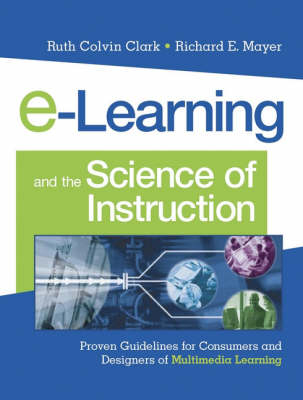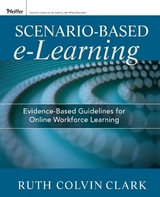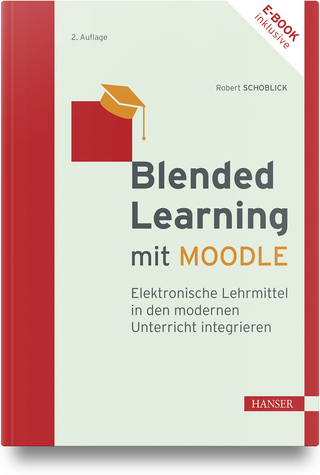
E-Learning and the Science of Instruction
Jossey-Bass Inc.,U.S. (Verlag)
978-0-7879-6051-3 (ISBN)
- Titel ist leider vergriffen;
keine Neuauflage - Artikel merken
In e-Learning and the Science of Instruction authors Ruth Colvin Clark and Richard E. Mayer- internationally recognized experts in the field of e-learning- offer essential information and guidelines for selecting, designing, and developing e-learning courses that build knowledge and skills for workers learning in corporate, government, and academic settings.
Ruth Colvin Clark has worked for more than twenty years with managers assigned to design, develop, and select effective training for classroom or computer delivery. She is widely published in the areas of training, development, and performance improvement. Her most recent book, Building Expertise, was awarded Outstanding Instructional Communication from ISPI. Richard E. Mayer is professor of psychology at the University of California, Santa Barbara. He is an internationally recognized expert in the application of learning psychology to design of instruction in multimedia learning environments and the author of Multimedia Learning.
Acknowledgements.Preface.Introduction.1. e-Learning: Promise and Pitfalls.The e-Learning Bandwagon.What Is e-Learning?e-Learning Development Process.Two Types of e-Learning Goals: Inform and Perform.Is e-Learning Better? Media Comparison Research.What Makes e-Learning Unique.e-Learning: The Pitfalls.What Is Good e-Courseware?Three Types of e-Learning.e-Learning to Support Human Learning Processes.2. How People Learn from E-Courses.How Do People Learn?How e-Lessons Affect Human Learning.What Is Good Research?3. Applying the Multimedia Principle: Use Words and Graphics Rather Than Words Alone.Multimedia Principle: Include Both Words and Graphics.Psychological Reasons for the Multimedia Principle.Evidence for Using Words and Pictures.4. Applying the Contiguity Principle: Place Corresponding Words and Graphics Near Each Other.Contiguity Principle: Place Printed Words Near Corresponding Graphics.Psychological Reasons for the Contiguity Principle.Evidence for Presenting Words at the Same Time as Corresponding Graphics.5. Applying the Modality Principle: Present Words as Audio Narration Rather Than Onscreen Text.Modality Principle: Present Words as Speech Rather Than Onscreen Text.Psychological Reasons for the Modality Principle.Evidence for Using Spoken Rather Than Printed Text.6. Applying the Redundancy Principle: Presenting Words in Both Text and Audio Narration Can Hurt Learning.Redundancy Principle One: Avoid Presenting Words as Narration and Identical Text in the Presence of Graphics.Psychological Reasons for the Redundancy Principle.Evidence for Omitting Redundant Onscreen Text.Redundancy Principle Two: Consider the Narration of Onscreen Text in Special Situations.Psychological Reasons for Exceptions to Redundancy Principle.Evidence for Including Redundant Onscreen Words.7. Applying the Coherence Principle: Adding Interesting Material Can Hurt Learning.Coherence Principle One: Avoid e-Lessons with Extraneous Sounds.Psychological Reasons to Avoid Extraneous Sounds.Evidence for Omitting Extraneous Sounds.Coherence Principle Two: Avoid e-Lessons with Extraneous Pictures.Psychological Reasons to Avoid Interesting but Extraneous Graphics.Evidence for Omitting Extraneous Graphics.Coherence Principle Three: Avoid e-Lessons with Extraneous Words.Psychological Reasons to Minimize Words in e-Learning.Evidence for Omitting Extraneous Words.8. Applying the Personalization Principle: Use Conversational Style and Virtual Coaches.Personalization Principle One: Use Conversational Rather Than Formal Style.Psychological Reasons for the Personalization Principle.Evidence for Using Conversational Style.Personalization Principle Two: Use Onscreen Coaches to Promote Learning.9. Does Practice Make Perfect?Design of Practice in e-Learning.Practice Principle One: Interactions Should Mirror the Job.Psychological Reasons for Job-Relevant Practice.Evidence for the Benefits of Practice.Practice Principle Two: Critical Tasks Require More Practice.Psychological Reasons for Multiple Distributed Practice Exercises.The Evidence for Multiple Distributed Practice Exercises.Practice Principle Three: Apply the Media Elements Principles to Practice Exercises.Practice Principle Four: Train Learners to Self-Question During Receptive e-Lessons.Psychological Reasons for Training Self-Questioning Skills.Evidence for Training Self-Questioning.10. Leveraging Examples in e-Learning.Worked Examples: Fuel for Learning.Worked Example Principle One: Replace Some Practice Problems with Worked Examples.Psychological Reasons for Using Worked Examples.Evidence for Benefits of Worked Examples.Worked Example Principle Two: Apply the Media Elements Principles to Examples.Psychological Reasons for Applying the Media Element Principles.Evidence for the Media Elements Principles.Worked Example Principle Three: Use Job-Realistic or Varied Worked Examples.Psychological Reasons to Adapt Examples to Task Types.The Evidence for Worked Examples That Support Transfer.Worked Example Principle Four: Teach Learners to Self-Explain Examples.Psychological Reasons for Training Self-Explanations.The Evidence for Self-Explanations.11. Learning Together on the Web.What Is Collaborative Learning?What We Know About Collaboration During Learning.Models for Productive Group Collaborations.Psychological Reasons for Collaborative Assignments.The Evidence for Online Collaborative Learning.12. Do Sur.ng and Learning Mix? The Effectiveness of Learner Control in e-Learning.Learner Control Versus Program Control.Do Learners Make Good Instructional Decisions?Psychological Reasons for Poor Learner Choices.Learner Control Principle One: Use Learner Control for Learners with High Prior Knowledge or High Metacognitive Skills.Learner Control Principle Two: Make Important Instructional Events the Default Navigation Option.Learner Control Principle Three: Add Advisement to Learner Control.Navigational Guidelines for Learner Control.13. e-Learning to Build Problem-Solving Skills.What Are Problem-Solving Skills?Problem-Solving Principle One: Use Job Contexts to Teach Problem Solving Processes.Psychological Reasons for Job-Specific Training.Evidence for Job-Specific Problem-Solving Training.Problem-Solving Principle Two: Focus Training on Thinking Processes Versus Job Knowledge.Psychological Reasons to Provide Metacognitive Worked Examples.Problem-Solving Principle Three: Make Learners Aware of Their Problem-Solving Processes.Psychological Reasons for Assigning Practice in Problem-Solving.Problem-Solving Principle Four: Incorporate Job-Specific Problem-Solving Processes.14. Applying the Guidelines.Applying Our Guidelines to Evaluate e-Courseware.e-Lesson Reviews.Sample One: Ammunition Safety.Sample Two: Creating Links in Dreamweaver.Sample Three: Accelerate Expertise-Researching Commercial Bank Loans.Sample Four: Identifying Hazardous Materials.The Next Generation of e-Learning.References.Glossary.Index.
| Erscheint lt. Verlag | 28.10.2002 |
|---|---|
| Verlagsort | New York |
| Sprache | englisch |
| Maße | 184 x 245 mm |
| Gewicht | 794 g |
| Themenwelt | Schulbuch / Wörterbuch ► Unterrichtsvorbereitung ► Unterrichts-Handreichungen |
| Mathematik / Informatik ► Informatik ► Grafik / Design | |
| Mathematik / Informatik ► Informatik ► Netzwerke | |
| Mathematik / Informatik ► Informatik ► Web / Internet | |
| Sozialwissenschaften ► Pädagogik ► Berufspädagogik | |
| Wirtschaft ► Betriebswirtschaft / Management ► Allgemeines / Lexika | |
| Wirtschaft ► Betriebswirtschaft / Management ► Personalwesen | |
| Wirtschaft ► Betriebswirtschaft / Management ► Unternehmensführung / Management | |
| ISBN-10 | 0-7879-6051-9 / 0787960519 |
| ISBN-13 | 978-0-7879-6051-3 / 9780787960513 |
| Zustand | Neuware |
| Informationen gemäß Produktsicherheitsverordnung (GPSR) | |
| Haben Sie eine Frage zum Produkt? |
aus dem Bereich



